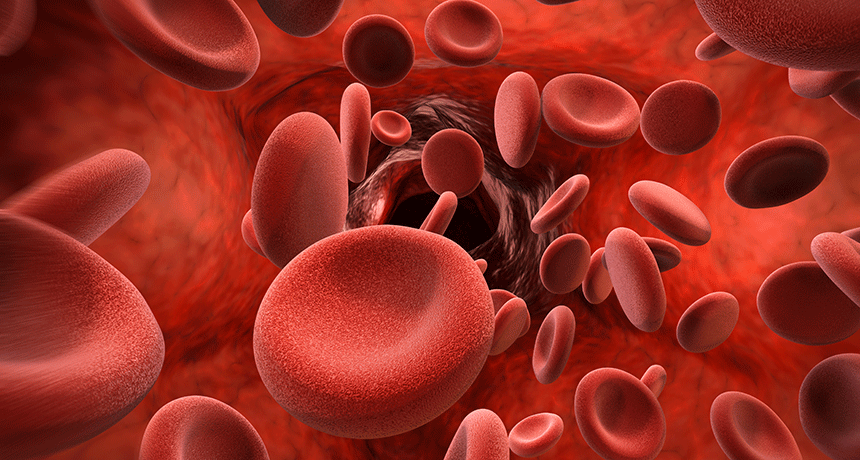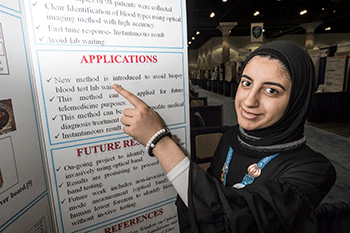Needle-free blood typing may be on the way
Teen researcher works toward identifying blood type using only light — no blood sampling required

In the future, figuring out someone’s blood type may not require a sample, just a device that shines light into the skin.
PhonlamaiPhoto/iStockphoto
By Sid Perkins
LOS ANGELES, Calif. — Everybody has blood, but we all don’t have the same type. So one donated pint of it may help — or do harm — depending on the recipe your genes had used to make your own blood. That’s why hospitals must collect a sample of blood and test it to know which donated blood to safely transfuse into patients who have suffered catastrophic blood loss. But that may change, a Kuwaiti teen now reports.
She’s just shown that it’s possible to discriminate between different types of blood using infrared light. In future, she says, this may mean nurses or lab workers could simply shine a light into your skin — and analyze the light that reflects back — to know which blood donation would be right for you. The good news: For this low-cost method, no needles would be required!
Blood is a complicated soup of particles and proteins. These include white blood cells, which help fight infection, and platelets, which help blood clot after an injury. But red blood cells are the most common. They deliver oxygen to tissues throughout the body and transport carbon dioxide back to the lungs. Red blood cells are important for another reason, too, notes Zainab Alnakkas. This 17-year-old at the Bayan High School for Girls in Kuwait points out that certain proteins or other substances on the surface of red blood cells help someone’s immune system react and fight foreign substances. These substances are known collectively as antigens.
There are four major blood types: A, B, AB, and O. A, B, and AB all have antigens (known by those letter names). Blood having none of these is known as O type. Particular proteins on red blood cells determines whether a person’s blood type hosts another type of antigen, known as Rh. Those that don’t are known as “Rh-negative” and those that do are considered “Rh-positive.” If the immune system encounters an antigen its host shouldn’t have, antibodies will form and attempt to fight the source of that antigen. That’s why it’s very important that a person receiving donated blood is given a type that is compatible with theirs (both in terms of the letter type and Rh factor), the teen explains.
Today, most labs identify a person’s blood type by testing a sample of the red stuff. Lab workers will check to see whether the blood’s cells contain various antigens. (They do this by adding various antibodies that can recognize those antigens, then looking for any reactions.)
But scientists also have shown that red blood cells of different blood types reflect light slightly differently. That’s especially true at certain wavelengths of infrared light, Zainab notes. So she wondered if she could use light to identify blood types.

She shone infrared light of three different wavelengths through the samples of blood from 30 people. Then she used sensors to measure the light reflecting from the samples at wavelengths between 10 meters and 30 centimeters. (All of these correspond to radio waves.) She also measured how much of an incoming wavelength of light was absorbed as it passed through blood. With yet another test, she measured the angle at which light was scattered by red blood cells.
In general, Zainab found, the fewer antigens there were, the less light that red blood cells absorbed. Also, blood with fewer antigens scattered less light. For example, the teen discovered that blood type O, which has no A or B antigens, scattered light less than other types. Blood type AB, which has both antigens A and B, scattered light the most.
Zainab showcased her research last week, here, at the Intel International Science and Engineering Fair. ISEF was created by Society for Science & the Public and is sponsored by Intel. The competition lets students from around the world show off their winning science fair projects. (The Society also publishes Science News for Students.) This year, nearly 1,800 high school students from more than 75 countries competed for big prizes and the ability to display their research.
Right now, Zainab’s technique still needs a blood sample to work. That means needles. (Ouch!) But in the future, engineers could make a device that shines the proper wavelength of light into a person’s skin. That light should be able to pass through the skin, bounce off of blood and then reemerge. Such a test could be done on blood still inside a person’s body, the teen explains.
The light scanner and analyzer used for this testing also could be portable, she notes. So, for example, emergency medical technicians could use it at the scene of an accident. Then, if someone needed blood for surgery, it could be waiting for them before they ever got to the hospital.







